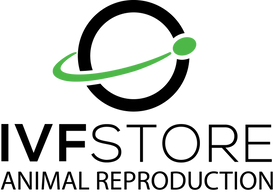Day 0: Fertilization IVF
Below is an introduction provided by Dr. Lotte Stroebech of Stroebech Media, detailing Day 0 fertilization protocols for IVF. These guidelines emphasize careful media preparation and equilibration, handling and assessment of matured oocytes, and proper semen processing to achieve optimal fertilization outcomes. By adhering to these best practices—covering everything from warming media to ensuring the correct sperm concentration—laboratories can enhance the efficiency and reliability of bovine IVF procedures.
Day 0: Fertilization IVF
Media to be equilibrated and warmed
Equilibrate the IVF Medium and warm the Semen Wash Medium in the bottle and with lid on
(IVC Medium with Oil overlay if overnight equilibration)
• Prepare and pre-equilibrate
• Prepare the number of wells corresponding to wells of matured oocytes or number of bulls to be used
• Prepare one dish per donor with
• Add 400 μl IVF Medium to all 4-wells of the 4WP with 500 μl being final volume (60 μl volume of oocyte plus ~40 μl volume of washed semen)
• OR 100 μl micro drops: Add 10 μl
Make drops in 4WP’s because drops in a petri dish risk floating together and potentially mix donors
Preparation of Matured Oocytes
• After 21-24 hours of IVM, remove matured oocytes from the incubator and evaluate and note cumulus expansion
• Rinse oocytes gently and only once with a 60 μl pipette through the equilibrated
• Do not divide oocytes at this time or disrupt the expanded cumulus cell mass
• Move oocytes into the designated IVF wells/micro-drops and incubate while preparing Semen
Semen Preparation
• Prepare a thermos container with 37°C warm water
• Label as many 15 ml centrifuge tubes as semen straws to be thawed
• Add 4 ml Semen Wash Medium per 15 ml centrifuge tube – keep warm
• Verify name of bull and quickly remove desired number of semen straws from LN2 and place into the thermos container
If a straw need to be cut in half –make sure that the straw is kept under liquid nitrogen at all times and leave the name of the bull on the unused half
• Dry straw(s) with sterile gauze and place in LAF bench or on a warm surface at 35°C stage
• Cut the end of the straw opposite from the cotton plug and place the straw just below medium surface inside tube.
• Cut the other end of straw off (the cotton plug) and allow semen to flow into the 4 ml Semen Wash Medium tube
• Place a drop of semen from the straw on a warm microscope slide, add coverslip and check the motility immediately
• Centrifuge using a fixed bucket and non-refrigerated centrifuge for 5 minutes at 328xg (RCF)
Do not confuse with RPM, which is rounds per minutes, and depends on length of rotor arm, whereas RCF is the relative centrifugal force (g). Make sure centrifuge tubes are conical and that centrifuge is not with swing arm but fixed buckets to get optimal pellet
• Remove supernatant with a sterile disposable 5 ml pipette and leave ~400 μl of the suspension and re-suspend pellet.
Remove supernatant immediately because swim-up occurs as soon as centrifugation stops
• Add again 2-4 ml pre-warmed
• Remove supernatant as described above and leave ~200- 400 μl and re-suspend pellet again to the final sperm suspension
• Calculate the concentration in the sperm suspension in order to calculate the correct volume to use for fertilizing
See Appendix 1 on how to calculate what volume sperm suspension to add to the IVF well or drop, respectively, to obtain 2 x 106 spermatozoa/ml per well/drop, which is the optimal fertilization concentration.
Example illustrated by using the Makler chamber counting device
Fertilization
• Take the IVF plates containing the matured oocytes from the incubator and fertilize by adding the calculated volume of sperm suspension and incubate overnight
If sperm motility and/or concentrations are low (<50%), double the calculated volume of sperm suspension to fertilize with to compensate. Incubate for 1 hour, and then remove twice the volume you added and replace with freshly equilibrated IVF medium. Incubate again.
Be careful not to aspirate any oocytes
Short protocol, i.e., fertilization for just some hours does not work as it does in human
Consider making the IVC plates on fertilization day to equilibrate overnight.



